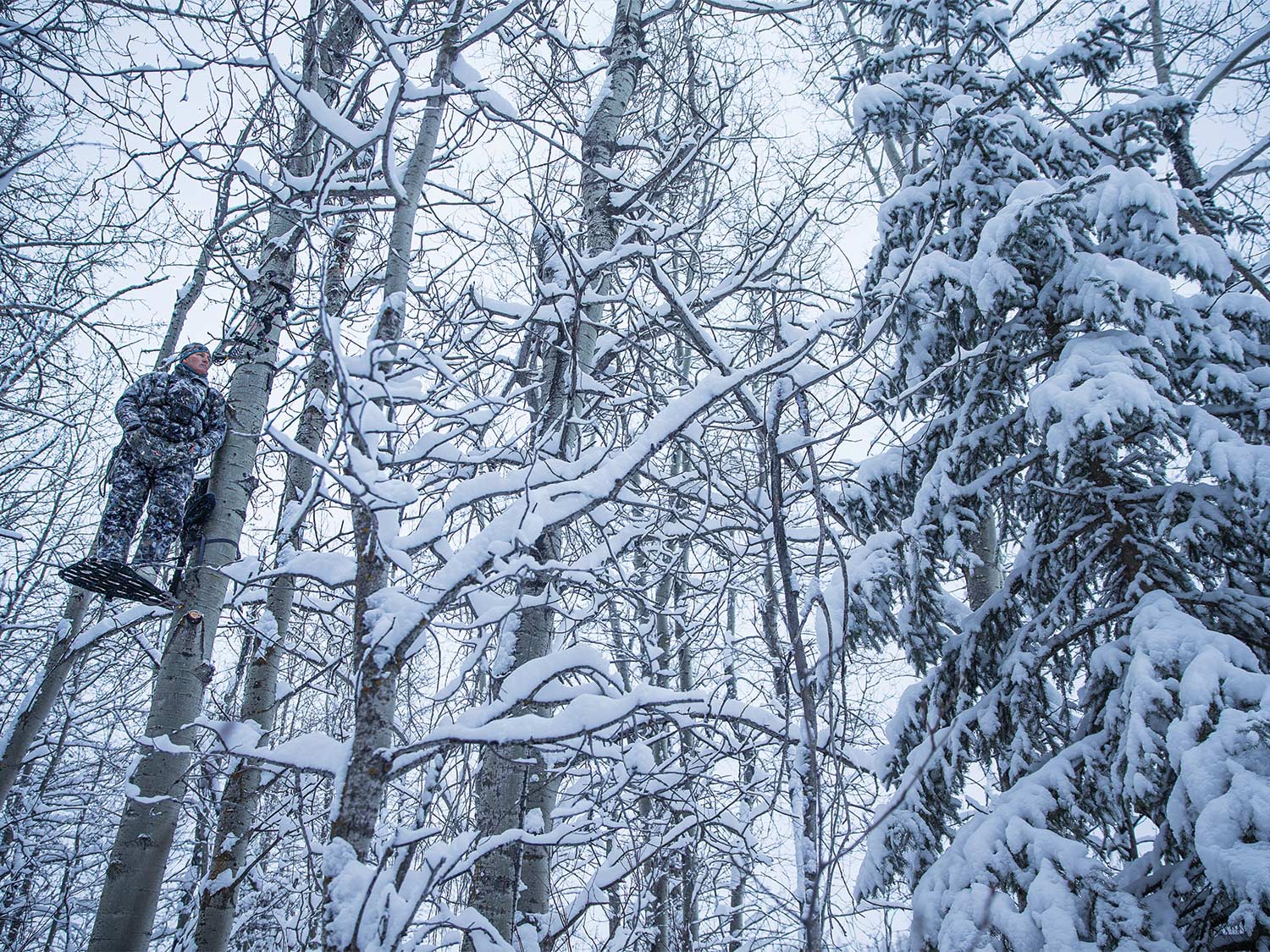We may earn revenue from the products available on this page and participate in affiliate programs. Learn More ›
Hunting whitetails in extreme cold is a little like parenthood. Rewards might await, but you’ve got to expect plenty of discomfort along the way.
Maybe it’s not that bad (whether I’m talking about brutal cold or parenting, I’ll leave to your imagination), but hunting in arctic weather can certainly be an exercise in perseverance. It’s also a wealth of burgeoning opportunity. In recent years, as wildlife managers try to find more ways to control deer populations, particularly in areas where chronic wasting disease outbreak-response plans call for substantial population reductions, extended late-season opportunities have become more abundant.
During these bitter-end hunts, the conditions that cause whitetails to move along consistent travel routes with predictable frequency are the same ones that make waiting on them so difficult: extreme cold.
We’re not talking about your run-of-the-mill cold. We’re talking about conditions that make 30-degree days seem like spring. The type of cold that freezes the snot in your nose and ices facial hair. Hunting in these circumstances requires special gear, special tactics, and a special frame of mind.
Double Wind-Stopping Layers
Hunt enough in truly cold weather, and you’ll quickly realize there is a difference between 15-degree temps and 15-degree temps with wind. Keep the wind from reaching your core, and you can stay warm—or at least warm enough to stay in position long enough to hunt the prime times of the day. But if the wind gets to you, you’re done.
Blocking the wind is your first order of business in wintery conditions. You already know the standard “dress in layers” mantra. You’ll need a moisture-wicking base layer to keep you as dry as possible. Then stack on layers featuring high-loft insulation. That’ll get you through most basic cold conditions. To endure the truly frigid, you’ll need at least one—preferably two—wind-blocking layers as well. I like to wear a wind-blocking vest under an outer layer that is also windproof. The one-two punch stops the heat-robbing wind and seems to make the high-loft insulation more effective.

Shelters
As good as today’s insulating materials and technical fabrics are, it’s hard to beat the comfort offered by a shelter in truly brutal weather conditions. For those who hunt the upper Midwest and Northeast, the deer shack is a staple for a reason: It’s effective, and it allows you to hunt longer and more comfortably in extreme cold.
Pop-up and hub-style ground blinds are handy and effective at concealment. But when you’re dealing with the coldest of conditions, they are inferior to a more permanent blind.
Commercial options featuring wind-blocking wall materials, sealed windows, and full insulation are excellent. They’re also fairly expensive. If you’re the DIY type, you can save a bit of cash by constructing your own. Just be sure to have a plan for getting your blind to your hunting location—those shooting houses are heavy.
Read Next: 3 Tactics for Hunting Wary Does This Winter
Supplemental Heat
I spent my first hunting seasons chasing whitetails in the big conifer stands and tamarack swamps of Michigan’s Upper Peninsula. If you’re wondering what damp cold feels like, spend a winter in the U.P. That said, the coldest I have ever been was on a hunt in the prairie habitat in Kansas. The winds ripping across that frozen moonscape were almost unbearable. My water bottle froze in my pack in just a few hours, and my fingers and toes barely functioned. I spent most of my time hunting from an enclosed blind that week, with a portable propane heater cranking just so I could stay afield longer. Without that heater, I’m not sure I could have hunted long or hard enough to be effective.
A word of caution here: Any device that relies on a flame gives off some amount of carbon monoxide, a deadly, odorless gas. Look for models with an auto-shutoff feature and a low-oxygen sensor. Or go old-school. In the deer-camp country of Michigan’s Upper Peninsula, it’s common to see (and smell) small wood-burning stoves in permanent blinds.
Disposable chemical heat packs are standard for extreme-cold hunts. I like the large body-size ones with adhesive backing. I’ll put one on each side near my kidneys, and toss a couple of hand-size packs in my jacket pocket. Stick-on toe warmers typically aren’t very effective inside your oxygen-blocking boots, but they can still be helpful.

Super-Cool Deer Gear
Sitka Fanatic Bib
Bibs are a must for extreme conditions, and Sitka’s Fanatic bib is my go-to. It has exactly the features needed to combat cold: a windproof layer and high-loft insulation. This revamped iteration of the Fanatic bib has smooth fabric on the bottom of the legs and inner thighs, to minimize the collection of burrs. ($439; sitkagear.com)
Heater Body Suit
If you absolutely must sit in a treestand during a polar vortex, this is one piece of gear you’ll want to pack in. Functionally a sleeping bag for hunters, the Heater Body Suit wraps you in a windproof, insulated cocoon. A suspender system and interior zippers allow you to unzip the bag, free your arms, and operate a gun or bow. It’s definitely warm, and its popularity among Canadian hunters is a testimony to its effectiveness in frigid locales. Practice deploying your gun or bow in this clumsy get-up long before a deer arrives. ($380; heaterbodysuit.com)
Clam Sub-Zero X Boot
This brand that makes icefishing gear understands a thing or two about cold-weather boots. The Sub-Zero X Boot is heavy. It’s bulky. It’s not especially attractive. But it’s damned warm. The rubber boots feature a removable liner, which is a critical part of the system. Any amount of dampness in a boot will greatly impact its ability to insulate. This boot can be completely dried between uses. ($180; ganderoutdoors.com)

